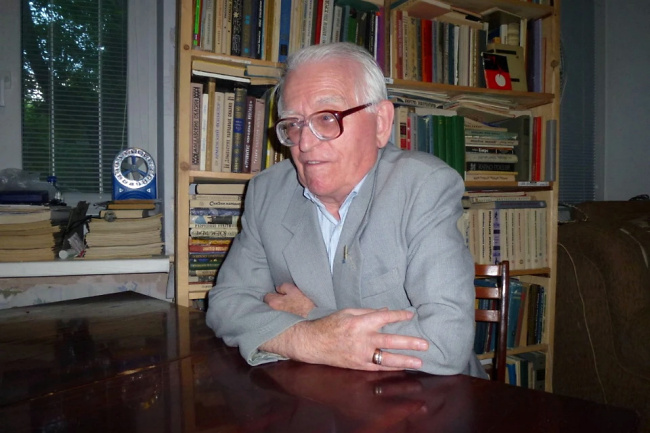
Important documents from the criminal case on the death of the hikers could have simply been stolen
Searcher Vladislav Karelin told under what circumstances he first got acquainted with the secret documents
October 31, 2021. All rights reserved Komsomolskaya Pravda. Authors Nikolay Varsegov and Natalya Varsegova
In the winter of 1959, nine ski hikers went missing in the mountains of the Northern Urals. Leader of the group was Igor Dyatlov. A month later rescuers found their tent cut open. Within a mile were discovered five frozen bodies. The rest were found only in May. The hikers died in a strange barely clad state. Some had fatal injuries. It is still not clear why the group fled into the severe frost and to their death.
A criminal case on the death of the hikers was opened when the tent and the first bodies - Krivonischenko and Doroshenko - were found. The investigation was conducted by the criminal prosecutor, junior counselor of justice Lev Ivanov. On May 28, 1959, he also decided: "the cause of the death of the hikers was an overwhelming force, which the hikers were not able to overcome."
On June 15, 1959, the criminal case was sent to Moscow at a request from above. On July 6, it returned to the Sverdlovsk prosecutor's office with a cover letter signed by the Deputy Prosecutor of the RSFSR Leonid Urakov, and sent by order of the regional prosecutor to the secret archive. Here is a postscript that a certain "package should be kept in top secret production."
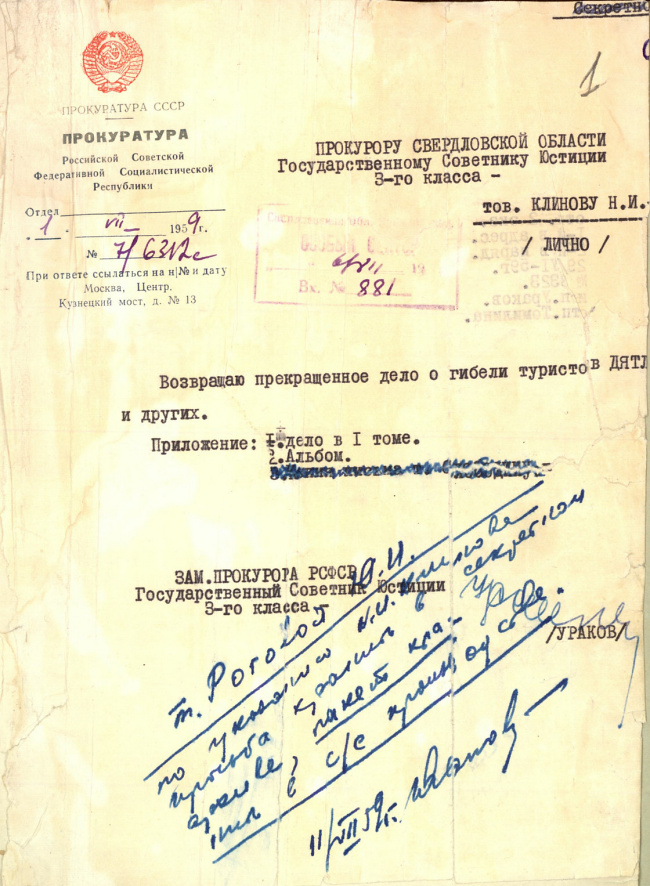
Deputy Prosecutor of the RSFSR Urakov returns the case. (translation)
It is unlikely that the "Dyatlov" case would have become public knowledge, if 25 years later, in 1984, the secrecy label had not been removed from it. And then the most curious thing began. The criminal case was secretly removed from the prosecutor's office so that everyone could read it. 62 years after the tragedy, a friend of Igor Dyatlov, a participant in the search for the dead hikers Vladislav Karelin, decided to tell us about this. His words.
- KP 2 -
A one night stand
"Opposite the building of the institute, where I worked, there was a factory, at that time a "mailbox". A hiking section was actively functioning at the plant, headed by Leonid Skripov. We often met on the sidewalk leading to the factory. Once, when we met, he asked me: "Would you like to see the criminal case on the death of the Dyatlov group?" I, of course, said yes. We agreed to meet the following day at the same place. The next morning I received the package. But with the condition that I can keep it for only one day. My work day turned out to be stressful. Therefore, I was able to open the package only in the evening at home. I flipped through the pages all night, until five in the morning. I made notes that I still have. In the morning I returned the volume to Leonid. I asked him: "How did you get your hands on the case?" He said he knows someone (either a relative or a good friend) who's working in the prosecutor's office. And since the secrecy label was removed from the case, the opportunity to get acquainted with it presented itself. Who else was able to look through this case at that time is unknown. It's a pity, but Leonid Skripov died a few years later while rafting on the Naryn River in Kyrgyzstan.
Top secret package
I read the case in a hurry of course. A number of documents remained outside the field of my attention. But the most surprising thing was the location of the package at the very end of the case. The package consisted of several sheets folded in half. In several places, the sheets were perforated with a hole punch. And a string was threaded into the holes, the ends of which were fastened with a wax seal. And in several more places on the holes of the package, the same wax seals were placed. And then I realized that this particular package was classified as "top secret". Such registration of secret documents was very familiar to me.
In the early 50s of the last century, I studied at the Physics and Technology Faculty of the Ural Polytechnic Institute. A number of special lectures, including a course on radiation safety, were "secret". Each student was given a notebook with holes, a cord and a wax seal. And you could make your notes at the lectures only in your personal notebook. Before the lecture it was given to us with a receipt, and after the lecture it had to be handed over also with a receipt.
The contents of the package interested me the most. I did not dare to break the wax seals. I began to carefully bend the free ends of the sheets. I saw excerpts from some tables. I read the word "radioactivity" several times. And I realized that the "top secret" package contains the results of measurements of radioactive contamination.
Next, I draw the reader's attention to the entry made by Ivanov: "Sheets of the case 370-378, as irrelevant to the case, were seized and stored in a special sector of the regional prosecutor's office."
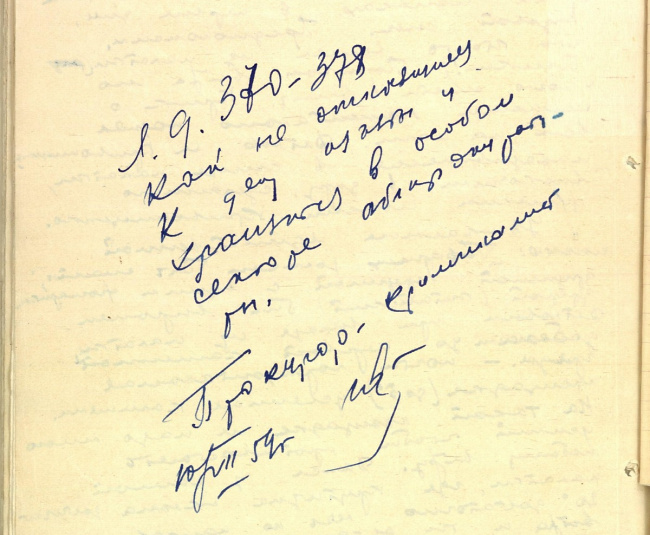
The order for the storage of documents in a special sector. (translation)
But if the package is attached to the criminal case, then the sheets were not seized. Probably, the regional prosecutor decided to keep it in the general documents, and not in the "special sector". And it is thanks to this "secret package" that the entire criminal case has been reliably preserved."
Where did the documents go?
The question of the reliable safety of all documents for us personally, the journalists of "KP", remains controversial. We have written more than once that there are not many procedural documents in the case - orders to conduct a forensic medical study, for example, or the results of histology. There is no answer to the question why the Ivdel Prosecutor Tempalov initiates a case and then suddenly becomes a witness. And much more. We attributed such flaws to the negligent work of the investigators. And what if the missing documents "secretly" were taken away as a memento by those who took to read the criminal case for one night, like Vladislav Karelin? We in no way accuse Vladislav Georgievich. But who knows how many times and for whom the case was secretly removed from the prosecutor's archive?
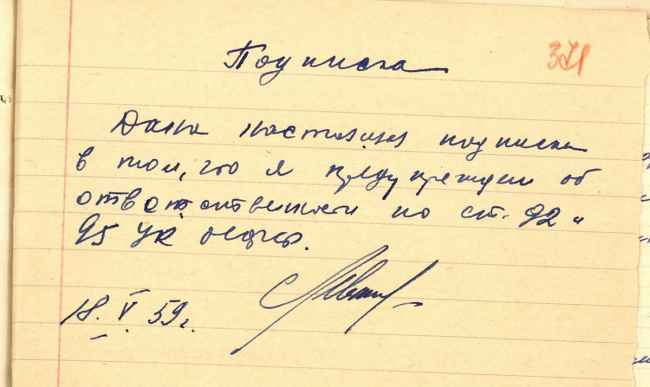
Expert Levashov's subscription (translation)
- KP 3 -
Copies instead of originals
And here's another curious moment. It's all about the same top secret package. Karelin saw this package sealed with sealing wax and stitched with a string. What do we see in the well-known copy of the criminal case?
- There are no puncture marks on most of the radiation examination sheets, - shows Vladislav Karelin. - They are only on the decree on the appointment of a physical and technical examination, and there is nothing on the signature of expert Levashov and on his conclusion. I don't think this conclusion is the original. And it is not written in Levashov's handwriting compared to his subscription. Thus, the physical and technical expertise with the results of studies of radiation contamination in 1959 was considered secret. Therefore, it was issued separately with the stamp "top secret" and was kept in a separate package. After the secrecy label was removed, some of the examination sheets were replaced with copies. But were all the sheets returned in the criminal case as not secret?
From the authors
After hearing what Vladislav Karelin had to say, we can speculate that one of the night readers of the case was not afraid, unlike Karelin, to open the sealed package. While opening it, he might have damaged the string. And the employee of the prosecutor's office, who took the liberty of taking out such a serious document from the archive, then eliminated his own transgression. Trimmed the torn edges where possible and included copies in place of the damaged originals. So, for example, the decision on the examination itself is a copy. Why? Is it because the original was negligently lost?
Only copies of the statement and questioning of expert Levashov can be found in the "Dyatlov" criminal case.

Resolution for radiological testing (translation)
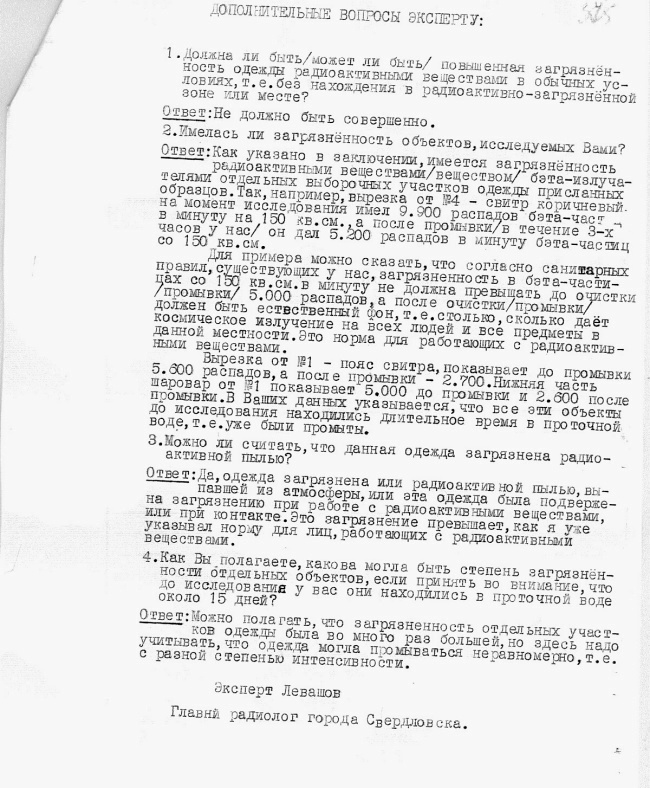
Questions to expert Levashov (translation)
Secrecy of the criminal case on the death of the Dyatlov group
Full version of Vladislav Karelin's article
In early February 1959, a group of hikers led by Igor Dyatlov tragically died on the slope of Mt Kholat Syakhl in the Northern Urals. An investigation was initiated "on the death of the hikers in the area of Mt Otorten", which was led by prosecutor criminologist Jr. Counselor of Justice Lev Nikitich Ivanov . On May 28, 1959, he closed the case with the resolution: "To terminate further proceedings on the criminal case on the death of the hikers." In his decision Lev Ivanov pointed out that "the cause of the death of the hikers was an overwhelming force, which the hikers were not able to overcome." At a request the criminal case was sent to Moscow on June 15, 1959. On July 6, 1959 it was returned to Sverdlovsk with a cover letter signed by Leonid Ivanovich Urakov, Deputy Prosecutor of the RSFSR. Here along the way, I will note that among the attachments to the letter were indicated:
- The case in volume 1.
- Album [these are photos - Karelin's note].
- [something carefully crossed out - Karelin's note].
Urakov didn't like something and crossed out a few words. It can be assumed that it was he who did not want to leave the crossed out words, since the ink on the crossed out and his signatures match.
After the expiration of the storage period, the secrecy stamp was removed from the case files. And somewhere in 1984 or 1985 this criminal case fell into my hands. Opposite the building of the institute, where I worked, there is a factory, at that time a "mailbox". A hiking section was actively functioning at the plant, headed by Leonid Skripov. We often met on the sidewalk leading to the factory. Once, when we met, he asked me: "Would you like to see the case files on the death of the Dyatlov group?" I immediately said yes. We agreed to meet the following day at the same place. The next morning I received the package with the condition to keep it for only a day and return the case the next morning. My work day turned out to be stressful. I was able to open the case files only in the evening, when I returned home. I leafed through the pages of the volume all night, until five in the morning. I made some notes that I still have. And in the morning he returned the volume to Leonid. I asked him: "How did you get your hands on the case?" He said he knows someone (a relative or a good friend) in the prosecutor's office. And since the case was declassified, the opportunity to get acquainted with it (the case) presented itself. Who else was able to look through the case files at that time is not known. It's a pity, but Leonid Skripov died a few years later while rafting down the Naryn River in Kyrgyzstan.
I will tell you about my night reading of the case files below.
It seems that even before me Evgeniy Polikarpovich Maslennikov and Yuri Evgenyevich Yarovoy saw the case files. This is evident by their subscription "on non-disclosure of data on the death of the students". Their signatures are dated May 14, 1959. These subscriptions are in the second volume of the case files, entitled "Observational proceedings". In 1966, Yuri Yarovoy published the book "The Highest Category of Difficulty". On page 155 of this book, he wrote that "the diaries and copies of the protocols are still in my hands." It is possible to believe that he saw the documents, since Yarovoy in his book describes many details as real past events. I found out later that Maslennikov and Yarovoy had access to the case files back in May 1959. While writing the book, Yarovoy discussed individual chapters with Maslennikov. A couple of times I took part in such discussions, which took place at Maslennikov's apartment. Yarovoy read his texts aloud, and we listened attentively, sometimes making notes on pieces of paper. And then we discussed what we heard. Based on the results of such debates, Yarovoy twice altered the main plot line. He changed the names of the characters so that there was no resemblance with the names and surnames of the real people. The famous cedar with a fire was called a pine. He put in the book a second hut and other things. Neither Maslennikov, nor Yarovoy told me that they were familiar with the case files. But in the course of our "readings" facts sometimes slipped through which, after my acquaintance with the case files, testified that both of them were familiar with the materials.
At the end of the 90s of the last century and especially at the beginning of the 21st, public interest in the events associated with the death of the Dyatlov group increased sharply, abruptly. The case files were declassified and kept in the archives of the regional prosecutor's office. After me the following people had access to the case files:
- Stanislav Bogomolov - in 1990 published an article "The Mystery of Fireballs" in several issues of the newspaper "Uralskiiy Rabochiy", in which he cited the documents from the case files, confirming his acquaintance with the case files; and later, in answers to questions, he noted that he leafed through the case files together with Karotaev;
- Moisey Akselrod - in the article "It seems to me that it was an avalanche", written in 1997 and published in the book by Evgeni Buyanov and Boris Slobtsov "The Secret of the Dyatlov Group Death" in 2011, wrote that he got acquainted with the case files;
- Aleksandr Gushchin – in 1999 he published "The price of a state secret is nine lives", citing documents from the case files, which at that time were kept in the archives of the regional prosecutor's office;
- Yuri Yudin – got acquainted with the case files end of 1999;
- Anna Matveeva – in 2000 in the magazine "Ural" she published an article "Dyatlov Pass", and a separate book after that, in which she cited a number of documents from the case files;
- In May 2001, Igor Aleksandrovich Dubinin and Tatyana Alekseevna Perminova (relatives of the dead hikers) were allowed to see the case files;
- Evgeni Buyanov – in 2009 and 2010 got acquainted with the case files and in 2011 published a book in collaboration with Boris Slobtsov "Mystery of the Dyatlov group death";
- Finally, in 2017, the case files was published in full at the initiative of the "In memory of the Dyatlov group" foundation.
- full version (2) -
In 1996, as certified by the inscriptions, the case files were transferred from the archive of the regional prosecutor's office to the state archive of the Sverdlovsk region. It is recorded when the case is received in the state regional archive. However, literally a month later, the case files were “requested for examination” and returned to the regional prosecutor's office. In 1999 Aleksandr Gushchin received the case files from the hands of the regional prosecutor. In 2001, Igor Dubinin and Tatyana Perminova got acquainted with the case files, and they were invited to the premises of the regional prosecutor's office. The date of the final transfer of the case files to the state regional archive is not known to me. the case files were in the state regional archive, but admission to it took place only with the permission of the regional prosecutor's office. In passing, I will note that the case number is missing on the title page of the case files. Lawyer Evgeniy Chernousov believes that, according to legal laws, any prosecutor's case must have a number. Journalist Aleksandr Gushchin writes that he saw the number of the case when he got acquainted with the case files - №659. However, this number is on the stamp of the regional archive, printed in fact when registering it in the regional archive - "storage fund R-2259, volume 1 - item 659, volume 2 - item 660".
Many Dyatlov case researchers draw attention to the fact that a number of documents in the case are not placed in the order of dates. For example, on page 1 of the file there is a letter from Leonid Ivanovich Urakov on the return of the criminal case from 07/01/1959. Or the interrogation of Georgiy Ivanovich Skoryh, (pp. 378-380 of the case), dated 07/29/1959 - after the closure of the case, etc.
Let's try to understand why such a rearrangement of materials occurred. In Moscow, the investigative units of the USSR Prosecutor's Office, as well as the RSFSR, monitored the progress of the investigation into the death of the Dyatlov group.
May 16, 1959 Nikolay Ivanovich Klinov, the prosecutor of the Sverdlovsk region, received a letter from the Investigation Department of the USSR Prosecutor's Office, which stated the following requirement: "I ask you to inform us about the results of the investigation and the decision taken in the case of the death of 9 students skiers" (see case files vol.2 p.58). Lev Nikitich Ivanov received instructions from Klinov: "Give an answer." But in the now publicly available case files there is no answer to the USSR Prosecutor's Office.
May 20, 1959 Nikolay Ivanovich Klinov from the Investigation Department of the Prosecutor's Office of the RSFSR received a letter with a request “To report on the results of the search for the rest of the group of hikers in Sverdlovsk who went missing in February of this year. in the Ivdel district "(see case files vol.2 p.59). In this letter Klinov wrote down the instruction: "Comrade Ivanov. Prepare an answer." And again, among the documents in the now publicly available case files there is no answer to the prosecutor's office of the RSFSR. From this letter of the RSFSR Prosecutor's Office it is clear that they had previously been interested in the death of the Dyatlov group, since in the letter itself asks to inform about the rest of the hikers group. Consequently, the RSFSR prosecutor's office already knew something about the first group of dead hikers.
Then on June 9, 1959, after the case was closed, Nikolay Ivanovich Klinov received a telegram from the USSR Assistant Prosecutor General Terebilov: "Send information about the decision taken on the death of students skiers." On this telegram Klinov wrote: "Comrade Ivanov. Send the case" (see case files vol.2 p.43). Usually, requests, read decrees, of a higher authority are executed within one to two days. Klinov gave an answer to the USSR prosecutor's office only on June 15, 1959, almost a week later: "I am sending the case of the death of students to Urakov by air on the fifteenth of June." (see case files vol.2 p.43) But Leonid Ivanovich Urakov at that time was the deputy prosecutor of the RSFSR, not the Union. It can be assumed that the delay was due to the formal disarray of the case files volume. Most likely, it was a "cumulative folder" of various documents. It was necessary to "comb" it, intertwine it, etc. Because of this, there was a delay. And in the rush they put some of the documents out of order.
On July 1, 1959, the criminal case was sent from Moscow to Sverdlovsk, where it was received on July 6, 1959. In this letter Lev Ivanov made the resolution (see case files receipt):
"Comrade Y.I. Rogovoy
per directions from N.I. Klinov
the request to be kept in a secret archive,
keep the package in top secret proceedings.
11.VII.59 Ivanov"
The words "keep the package in top secret proceedings" were underlined. From this record of Lev Ivanov unambiguously follows that the case files included a package that was classified as "top secret". Therefore, it is safe to assume that it is precisely the mention of the package with the stamp "top secret" in the letter that does not have such a stamp, that Leonid Ivanovich Urakov considered unacceptable, which is why he crossed out the text about the mention of the package.
Evgeniy Buyanov reports in his book that he, together with lawyer G. Petrov, established the contents of the "secret package". In their opinion, the secrecy of the case arose "after the return of the" case "from Moscow". I am having a hard time agreeing with this. It is clear from Urakov's letter that the materials of the case files sent to him consisted of three parts: the case files volume, the album [of photos], and something that Urakov crossed out in the cover letter. The first three words in the crossed out text correspond to the words "physical and technical expertise". Urakov crossed out these words. Consequently, they [the words] constituted a formally inadmissible phrase in Urakov's open letter, i.e. were classified. Considering the above, as well as the absence of cover letters sent from Sverdlovsk to Moscow, among the publicly available case files, it should be considered that the physical and technical expertise from the very beginning was classified as "top secret." This is probably why Levashov's conclusion in an open criminal case is presented in the form of a copy, although signed by Levashov, and not the original, which is classified. Investigator Lev Ivanov in his article "The Mystery of Fireballs", published in 1990 in the Kustanay newspaper "Leninskiy Put", wrote: "When I reported to Afanasiy Fyodorovich Eshtokin [second secretary of the regional committee of the CPSU - Karein's note] about his findings - fireballs, radioactivity, he gave categorical instructions: to classify absolutely everything, seal it up, hand it over to the special unit and forget about it. And in an interview with correspondent Stanislav Bogomolov Lev Ivanov to the question - "Who and why classified the case?" - Lev Ivanov replied: "I did it myself, I withdrew the radiation test report. I was told to remove everything that is irrelevant."
Thus, most likely, the primary reason for classifying the case files was the physical and technical radiological examination.
- full version (3) -
And now I will return to that sleepless night when I first leafed through the first volume of the case files. I read the case in a hurry of course. A number of documents remained outside the field of my attention. But the most surprising thing for me was the package at the very end of the case. The package consisted of several sheets folded in half. In several places, the sheets were perforated with a hole punch. A string was threaded into the holes, the ends of which were fastened with a wax seal. The same wax seals were placed in several more places on the holes of the package. Then I realized that this particular package was classified as "top secret". Such registration of secret documents was very familiar to me. In the early 50s of the last century, I studied at the Physics and Technology Faculty of the Ural Polytechnic Institute. A number of special lectures, including a course on radiation safety, were "secret". Each student was given a notebook with holes, a cord and a wax seal. And you could make your notes at the lectures only in your personal notebook. Before the lecture it was given to us with a receipt, and after the lecture it had to be handed over also with a receipt. In this notebook, we also took notes in laboratory classes, learning how to measure the levels of radioactivity in its various forms. By the way, I would like to note that such laboratory exercises were conducted under the supervision of L.B. Levashova (maiden name Hamzina), who graduated from the Physics and Technology Faculty of the UPI in 1952.
The contents of the package located at the end of the case files and included in the bound volume interested me very much. I did not dare to break the wax seals. I began to carefully bend the free ends of the sheets. I saw excerpts from some tables. I read the word "radioactivity" several times. And I realized that the "top secret" package contains the results of measurements of radioactive contamination. It didn't surprise me then. At that time, all documents that dealt with radioactivity were outright made out as secret.
Next, I bring to the attention of the reader the entry made by Lev Ivanov on the back of p.369 of the criminal case:
"C.S. [=Case Sheets] 370-378
are removed and stored
as irrelevant in a special sector
of the regional prosecutor's office
Prosecutor criminalist
10.VII.59 Ivanov"
I have to express my surprise. Lev Nikitich Ivanov writes about the "removal" of nine sheets from the case files, which should have been kept separately "in a special [ie secret - Karelin's note] sector of the regional prosecutor's office. However, after 25 years I saw that these sheets are at the end of the case files volume, and not separately "in a special sector". Probably someone, most likely Nikolay Ivanovich Klinov, decided that it would be better not to remove the nine sheets from the case files, but to store the entire volume of the case "in a special sector". It is thanks to this "secret package" that all the case files have been reliably preserved to this day.
Let's take a closer look at these "secret" nine sheets, which are now in the declassified volume of the case files. First of all, it is necessary to note a very obvious fact: on most of these sheets, traces of punctures are not visible. On p.370, which contains the decree on the appointment of a physical and technical examination, traces of punctures are present. Page 371 with Levashov's subscription is only 120 mm wide. The puncture marks could simply be cut off. On pp. 372-374 is Levashov's conclusion, and there are no perforation marks. Therefore, this conclusion is not original. In addition the conclusion is not written in Levashov's handwriting (as the subscription p.371). In addition, the conclusion is written on sheets with a width of 165 mm, which is not the typical width of the majority of pages in the case files on which there is no room for punctures. On the back of p.374 is Levashov's signature and it says "the study was carried out in a radiological laboratory from 18/V-59 to 25/V-". Nevertheless, near the signature of Levashov is the date "27/V-59". On pp. 376-377 are "Additional questions to the expert" [Levashov - Karelin's note]. These sheets contain Levashov's answers to additional questions from the investigator. Judging by the handwriting, the text on these sheets was written by Levashov's hand. But the date is "29.V.59", i.e. Levashov gave these answers after the case was officially closed (May 28, 1959). The width of these three sheets is 135 mm, i.e. puncture marks on these sheets were cut off. This is confirmed by the fact that on the back of p. 377 "cut off" part of the decoding of the surname "Levash".
So the physical and technical expertise with the results of studies of radiation contamination in 1959 was considered secret. This examination was drawn up separately with the stamp "top secret" and was kept in a separate package, which was later enclosed at the end of the case files volume 1, but corrected. Later, after the secrecy stamp was removed, some of the examination sheets were replaced with copies, and on other sheets the puncture marks on the left and right of the texts were cut off. All the "cleaned up" sheets were included in the case files as not secret.
Some Dyatlov case researchers believe that the secrecy of the case files was allegedly associated with some secret actions of the military. However, as shown above, the real reason for the secrecy was the physical and technical examination of radiation contamination, which, at the request of that time, had to be classified.
In conclusion, I note that a number of documents related to the death of the Dyatlov group (for example, the original of the physical and technical examination of Levashov, letters from Nikolay Ivanovich Klinov to the prosecutor's offices of the USSR and the RSFSR, a cover letter when sending the case files to Moscow, etc.) remain unknown. Maybe they are still kept in the closed or already declassified correspondence of the regional prosecutor's office.

